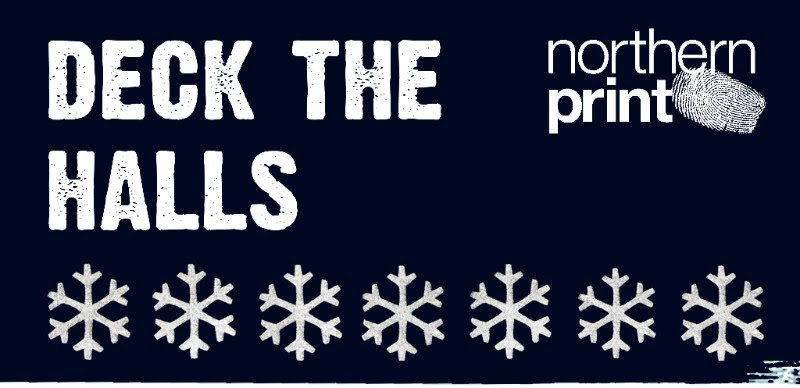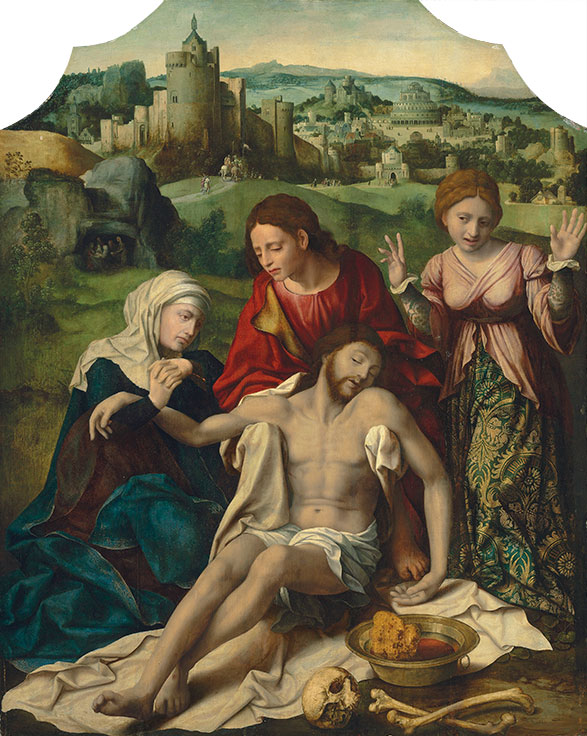| |||||||||||||||||||
| |||||||||||||||||||
| |||||||||||||||||||
|
Discovery: In the name of the father
How specialists in the Old Masters department at Christie's, a team of outside experts and the use of infrared reflectography revealed the centuries-old family secrets beneath The Lamentation — offered for sale at the Old Master & British Paintings Evening Sale on 8 December
When it was brought to Christie’s, The Lamentation was thought to be the work of Cornelis van Cleve — a Dutch painter born in Antwerp, who lived from 1520-1567. But something about the work’s composition — and a remarkably similar altarpiece in the Louvre — led experts to question the existing research. What they went on to discover would transform everything that had been previously accepted.
‘For any artist we research, we refer to the painter’s most recent catalogue raisonné, if there is one, and other literature relevant to the school and period of the painting in question,’ explains Christie’s Old Master Painting specialist Assunta von Moy, who was among the team that first examined the work. ‘In this case, we turned to Max J. Friedländer’s book on Early Netherlandish Painting.’
Workshop of Joos van Cleve (Cleve circa 1485-1540/1), The Lamentation. Oil on panel, marouflaged, shaped top. 57 1/2 x 46 in. (146.1 x 116.9 cm.). Estimate: £150,000-200,000. This work is offered in the Old Master & British Paintings Evening Sale on 8 December at Christie’s in London
A quick look into the artists active in Antwerp reveals that Cornelis van Cleve came from impressive artistic stock: he was the son of Joos van Cleve, an artist who, along with Jan Gossaert and Bernard van Orley, was considered the foremost painter of his day. ‘[Joos van Cleve] had a distinct and highly successful style, combining technical accomplishment in oil, inherited from the early-Netherlandish painting tradition, with a rich palette indebted to Northern Italian — especially Venetian — models,’ comments von Moy.
The young van Cleve was much inspired by his father and following Joos van Cleve’s death in 1440, Cornelis is believed to have become a master in the Antwerp painter’s guild, working to continue a family tradition that had produced some of the finest paintings of the Northern Renaissance. Much like those of his father before him, Cornelis’ works displayed the influence of Italian painters such as Andrea del Sarto, yet in a more mannerist style than his father.
In The Lamentation, however, the link between father and son’s work became more striking still. The similarity between the painting, attributed to Cornelis (above), and The lamentation over the dead Christ — an iconic altarpiece by Joos van Cleve (below), now displayed in the Louvre in Paris — was uncanny.
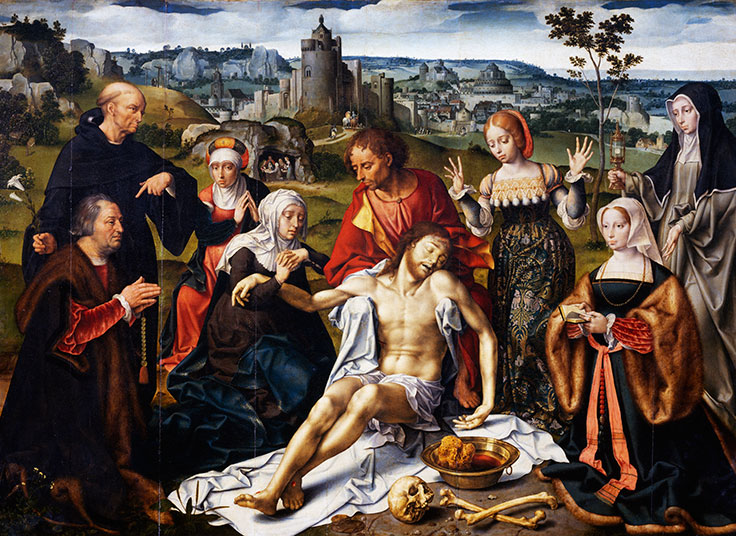
Joos van Cleve (circa 1485-1540), Alterpiece of the lamentation over the dead Christ, from the Church of the Friars Minor in Genoa, circa 1520. Detail. Paris, Musée Du Louvre
‘Apart from the figures’ faces, hands and some of their attire, reduced to the central group, the composition, the colour scheme and the detail was identical to the Louvre panel,’ explains von Moy. Produced around 1524, the work by Joos van Cleve was amongst his most famous, originally commissioned by the patrician Niccolào Bellogio for his chapel in the Genoan church of Santa Maria della Pace.
Depicting a dramatic group of mourners — the Virgin, Saint John and the expressive Magdalene — surrounding Christ’s dead body, the panel presented to Christie’s showed the same perfect foreshortening as Joos van Cleve’s masterpiece; the figures in each work so similar in scale that they might be copies of one another. ‘It made us wonder whether there was anything below the painted surface, such as traces of under drawing, that might offer an explanation,’ von Moy recounts.
To gauge whether her suspicions were justified, von Moy consulted an external expert: Peter van den Brink, Director of the Suermondt Ludwig-Museum in Aachen, Germany, and a specialist in artists active in Antwerp during the 16th century. ‘Peter was very interested in the painting and the relationship to the Louvre work,’ reveals von Moy. ‘He confirmed what we all thought: that it would be intriguing to do an infrared reflectography of the painting.’
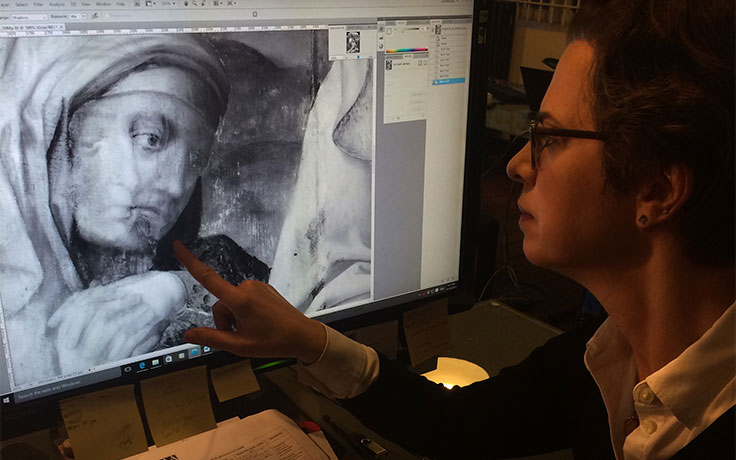
Dr Jilleen Nadolny, Principal Investigator for AA&R London, looks at an infrared of the panel consigned to Christie's, and on the face of the Virgin sees the outline of an earlier drawing that corresponds exactly with the depiction on Joos van Cleve's altarpiece in the Louvre
Christie’s approached Art Analysis & Research (AA&R), one of the world’s leading art laboratories. Its advanced techniques have been used for a variety of purposes, from dating unattributed works to identifying forgeries. ‘Our images are highly useful in the identification of pentimenti — any aspect of the work that changed as it progressed, or change that is not meant to be visible in the final version,’ Dr Jilleen Nadolny, Principal Investigator for AA&R London, explains.
Similar to X-ray, infrared reflectography allows experts to literally ‘see through’ layers of paint otherwise impenetrable to the naked eye. Long waves of infrared radiation are passed through the layers of paint on the surface before being reflected back to a camera sensor to varying degrees. ‘Paint with a light tonality will reflect infrared, whilst black pigments will absorb,’ says Nadolny. The resulting image — a glimpse beneath the surface — is known as an infrared reflectogram.
Drag left and right with the image slider to see the image of the panel originally thought to be by Cornelis van Cleve and the scan which reveals its secrets
This infrared reflectogram was expected to reveal ‘underpainting’ — the ghostly trace of early designs, laid out in the very first stages of the work’s creation. ‘With Old Masters, we sometimes find an early work that was abandoned, or a drawing laid out by a master and repainted by his studio,’ Nadolny comments. ‘You can get a lot of insight into the complex processes of a workshop, where you often had a number of people working together — particularly for large altarpieces.’
In the case of The Lamentation, infrared reflectography revealed something remarkable, however. Beneath the visible layer of paint, lay an entirely different image — an earlier drawing and paint layer whose design corresponded exactly to that of Joos Van Cleve’s altarpiece in the Louvre. Christie’s specialist Assunta von Moy explains the findings: ‘The ghostly shape of the Virgin’s upright oval face can be seen clearly beneath the surface.

From left: The face of the Virgin in The Lamentation, the scan which reveals an earlier drawing of a more upright face, which corresponds exactly with that of the face in Joos van Cleve's earlier work (right)
There is more: ‘The Magdalene’s headdress and extravagantly lavish bodice, embroidered with pearls and tassels, is also made visible. Like the Virgin, her small elegant head corresponds precisely to that in the Louvre panel.’

The scan reveals matching details on Mary Magdalene's lavish bodice and dress, both below and above the waist (centre and right)
Other details, too, suggested a link between the two works that was beyond the purely coincidental: ‘In the infrared reflectogram, St John, returns to the more mature and emaciated figure (below right) who features in Joos’s Genoese altarpiece. The underpainting reveals that the present work also corresponds exactly to the LouvreLamentation in its details — for example, the locks framing John’s face, the button of his shirt, and the same pattern of the Magdalene’s brocaded dress.’

From left: St John is transformed from the more youthful figure in the work consigned to Christie's into the older, more drawn presence in the earlier work. The position of the button and his hair are also the same
For Peter van der Brink, the results were conclusive: ‘The fact that the original figures here are of exactly the same size as those in the Louvre panel, would mean you have an exceedingly strong argument to place the picture in Joos’ workshop in the second half of the 1520s.’ In other words, Joos himself may have been involved in the creation of this painting — long believed to have been painted by Cornelis many years after his father’s death.
For Christie’s Old Master specialists, the shared height of the two panels suggested that a single ‘cartoon’, or highly refined to-scale preparatory drawing on paper, had been used for both the Louvre work and The Lamentation. An examination of the Louvre’s underdrawing, however, showed a freeness of style that suggested this mechanical transfer was unlikely. Far more probable was that Joos had entrusted his finished work to an assistant, who traced its design by placing oiled paper onto the dried panel.
Further supporting the theory that the paintings were contemporaneous was the eventual location of Joos’ altarpiece — in an Italian church hundreds of miles from his Antwerp workshop. ‘The fact that it relates in so many details to the original, including the colours, suggests that it was probably executed immediately after the completion of the Santa Maria della Pace Altarpiece, before the latter was dispatched to Genoa,’ von Moy adds.
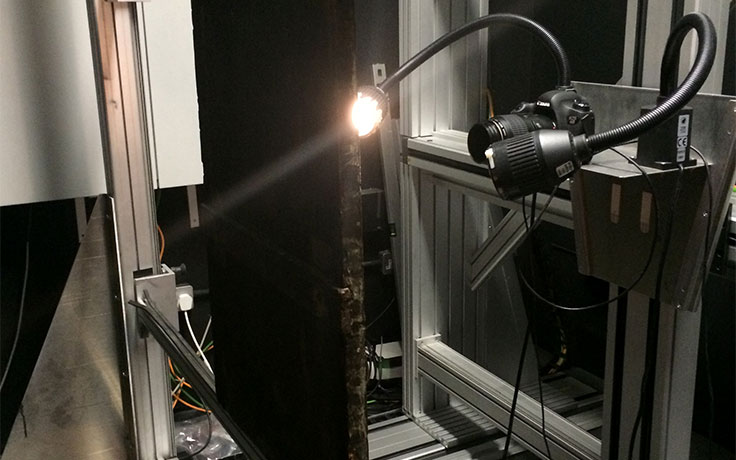
The scanner is a mechanised metal frame system on which a painting (here a panel, seen from the reverse, to the left) is mounted. To the right, the camera in use and the lighting system are moved along in automated increments, the camera taking a series of high resolution images at precise intervals.
Van der Brink had no doubt that Joos’ studio would have been capable of producing two works of such scale and ambition: ‘I have always held the opinion that Joos’ studio was one of the most efficient in early 16th century Antwerp.’ Indeed, Joos van Cleve is understood to have employed a team of highly skilled assistants, each specialising in different areas — including drapery, landscape, and brocade — while the master himself would focus on original designs, figures, and finishing touches.
‘The high quality of the original passages in the work offered in our sale, such as the still life in the foreground and the landscape in the background, are on a par with original works emanating from [Joos van Cleve’s] studio,’ says von Moy. ‘As in many of his large-scale paintings, Joos may have been responsible for this panel’s original faces, whose quality may only be appreciated today with the aid of the infrared reflectogram.’
Cornelis would have been just a boy when this panel was painted, but he could conceivably have inherited it with his father’s studio
Though research now appears to identify Joos, unmistakably, as the true author of The Lamentation, its life beyond Joos death is still a mystery. ‘The question remains as to why, when and by whom this panel was subsequently adapted,’ says von Moy. ‘The figures that are now visible display a more mannerist style, datable to the mid-16th century, if not later, closely resembling the work of Joos van Cleve’s son Cornelis.’
Cornelis would have been just a boy when this panel was painted, but he could conceivably have inherited it with his father’s studio — perhaps as an unsold work or a commission that was never paid for. ‘He, or perhaps one of his associates, may then have wished to assert their own character on the picture through the repainting of its principal figures — perhaps in an attempt pass it off as their own work,’ von Moy speculates. ‘It may have occurred as Cornelis was trying to cement his own reputation, or possibly around 1546, when he was struck by financial difficulties.’
What is certain, though, is that the exceptional story of The Lamentation makes it a far more complex work than ever previously thought. The etched lines, reworked brushstrokes, and hidden faces that lie beneath its surface combine to reveal an elaborate history of ownership, artistic identity and one of art’s most famous dynasties.
‘Both the genesis and the afterlife of this painting, make it a key witness to the fascinating complexity of artistic practices in Antwerp during the Northern Renaissance,’ confirms von Moy. Beneath its melancholy surface, there is — quite literally — more to The Lamentation than meets the eye.
